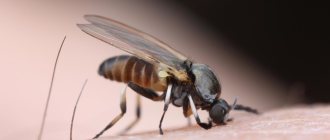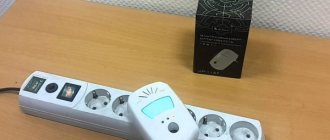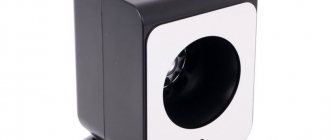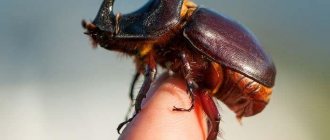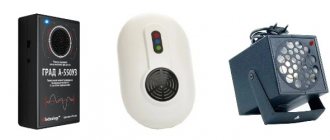How does ultrasound affect insects?
Insects are arthropod invertebrate animals that have a very hard chitinous cover, which is essentially an external skeleton. Chitin, by the way, in some insects is one and a half times stronger than steel. Under the exoskeleton is living tissue consisting of layers of fat and hemolymph.
The chitinous plates of insects can resonate, they vibrate even under the slightest mechanical influence of external conditions, including acoustic waves, and the gel-like composition of the tissue enhances this effect. Here we should remember the laws of physics, according to which mechanical vibrations are transmitted in liquids at a much higher speed than in other media. For example, the speed of sound in air is a little more than 330 meters per second, and the speed of sound in water reaches 1485 meters per second.
Interestingly, the effect of high-volume sound waves on insects can be compared to the low-frequency shock wave of a subwoofer in a car or a bass guitar at a rock concert, which are not only heard, but physically felt in the stomach.
However, unlike insects, human skin is an excellent sound absorber, and it dampens ultrasound, while chitin resonators, on the contrary, enhance it. The result of such exposure is both painful sensations in arthropods and the failure of certain systems and organs.
The sound spectrum is divided into three areas, in our case it is the red sector
Among other things, ultrasound is perfectly reflected from dense, and especially smooth, surfaces, which include walls, ceilings, floors, wooden or plastic furniture in a room, which implies a continuous, multiply amplified acoustic attack on insects anywhere in the room where there is such type of radiation.
Advantages and disadvantages
Using ultrasound to repel insects is a relatively new idea and does not work in every case. The versatility of ultrasonic repellers is an even more controversial fact, but such devices could theoretically be applicable to combat specific types of arthropods. In the end, even device manufacturers themselves often advise using the latter as additional control measures, along with pest control.
The positive qualities of ultrasonic insect repellers include:
- long working time,
- high efficiency,
- safety for people and pets,
- ease of use,
- no use of chemicals,
- low degree of energy consumption,
- ability to cover large areas,
- versatility.
Based on numerous reviews, the advantages of ultrasonic devices are nothing more than an advertising ploy by manufacturers and sellers.
Among the disadvantages of ultrasonic repellent devices, the following are usually noted:
- low efficiency in cold air,
- the risk of very high power devices affecting humans and domestic animals,
- sometimes pests become accustomed to them,
- high cost.
Types of ultrasonic repellers
Ultrasound of sufficient power has a negative effect on almost all types of living organisms, including animals, insects, birds and fish. It is also interesting that very high frequency sound waves, when used correctly, kill bacteria and certain types of viruses, and this is successfully used in medicine to treat a particular disease. Among the insect repellers using this technology, the most common are:
- stationary devices powered from a standard electrical network;
- portable gadgets powered by batteries or rechargeable batteries;
- combined devices for home and field use;
- less commonly, solar-powered devices.
Insect and rodent repellers
The frequency range from 25 to 45 kHz is known to cause the greatest discomfort in most rodents and insects. However, for example, cockroaches, mice and rats very quickly get used to unbearable conditions, which is why the frequency of sound vibrations of a high-quality repeller is floating, that is, it changes in tone at certain intervals.
The ultrasound produced by such devices has a destructive effect on the nervous system of insects and animals.
Universal devices work against both insects and rodents
Universal emitters
Ultrasonic devices of wide application can be used with equal success against ants, mosquitoes, flies, cockroaches, bedbugs, lice and other pests and parasites. There are a lot of different variations of electronic ultrasonic insect repellers on the market, and, according to the developers, gadgets will soon replace poisons and fumigators, due to their greater efficiency and environmental friendliness.
Ultrasound against mosquitoes
The ultrasonic mosquito repeller imitates the mating squeak of the male of these insects. Fertilized females that bite people cannot tolerate this sound and try in every possible way to avoid it. Some models replicate the squeak made by bats. Mosquito repellers are replacing chemical sprays, fumigators and creams.
According to the author, whether this is actually true is difficult to say for sure, but electronic devices have certain advantages over traditional methods of protection, including the absence of chemicals and odor. In addition, the effect of such repellers is aimed exclusively at mosquitoes.
Anti-cockroach devices
Domestic cockroaches have no natural enemies, but they cannot tolerate high-frequency signals. The problem is that cockroach devices, due to the characteristics of the latter, have an increased flow of ultrasonic radiation, so much so that it can negatively affect people and pets.
Anti-fly devices
Familiar insects can drive anyone crazy. Not only are they overly intrusive and annoying, but they are also carriers of all kinds of infections, some of which are very dangerous and even fatal. In this case, an ultrasonic repeller can be a good way out of the situation, however, the effectiveness of these devices, as well as all repellers with ultrasound, judging by the reviews, is very doubtful.
Often such devices are not repellers, but “spookers”, that is, they do not drive away flies, but, on the contrary, lure them
Ultrasonic gadgets against ants
As you know, small house ants in a human home are a very unpleasant neighborhood. They can be killed or expelled using both chemical disinfestation agents and specialized repellers. Such devices are distinguished by local action, but there are very few of them on the market. Judging by the reviews, universal emitters with the option of repelling ants do not work properly.
In addition to the listed narrowly targeted gadgets for repelling using ultrasound, there are also:
- ultrasonic tick repellers,
- bedbug repellers,
- flea devices,
- anti-spider devices,
- ultrasonic devices from wasps,
- mole repellers,
- ultrasonic bird repellers,
- snake repellers,
- devices from bats.
Operating principle
A modern device that repels insects and rodents must be connected to an outlet. The high-frequency sounds it emits have a negative effect on pests.
They experience stress, confusion, seizures and sometimes death. The constant stress that pests experience from the high-frequency device does not allow them to reproduce and eat. Therefore, they move out of its radius of action.
Research has shown that the mechanism that imitates the signal of a bat is most effective against insects, because the bat is their main fighter.
Instructions for use
The author of the article studied the instructions for use for several models of insect repellers and made the following conclusions.
Ultrasonic devices for repelling insects, as a rule, do not require additional measures to prepare them for operation. Batteries or an accumulator are inserted into the stand-alone device, and the network gadget is connected to an outlet. Most manufacturers recommend turning on the device continuously for a certain period of time, depending on the model. A high-quality product does not have the tendency to overheat, make extraneous noise or emit an unpleasant odor. Typically, crawling insects leave the house after one to four weeks; subsequently, connecting the device is necessary for preventive purposes.
Video: testing ultrasonic emitters of different models
Please keep in mind that the above figures are not exact and depend on the brand and model of the repeller. In addition, it is necessary to take into account the load on the room with furniture, soft or hard objects, partitions, and other interior items. The device is installed according to a diagram as close as possible to the image below.
When installing an ultrasonic insect repeller, follow this diagram and recommendations
Safety rules and precautions
When using an ultrasonic emitter, you should follow standard safety rules for household electrical appliances, including:
- Do not plug the product into dangling or broken sockets;
- do not clutter the switched-on device with furniture or interior items;
- do not turn on the device at ambient temperatures above or below the values specified in the instructions;
- do not connect the gadget in conditions of high humidity;
- Do not use a faulty repeller.
When using an ultrasonic insect repeller, you must also adhere to the following measures:
- do not place the device near the sleeping area;
- periodically turn off the device, especially if it overheats;
- Monitor your pets; if they exhibit unusual behavior, you should stop using the emitter;
- If people experience headaches or deterioration in their general health while using the ultrasound device, it is necessary to stop using it.
Do repellers affect humans and pets?
This is perhaps the most pressing and unexplored question. Ultrasound has a higher vibration frequency than the low-frequency spectrum and is not perceived by the human ear. However, no one has canceled the individual characteristics of hearing and the irritating effects of sound vibrations, including inaudible ones. Most likely, ultrasonic waves can still affect a person’s condition, although he often does not realize this. This influence in a mild form is expressed in changes in mood, headaches, to which we do not attach significant importance; in more severe cases, it may include panic, mild depression, diarrhea, nausea and vomiting.
Dogs, as a result of the work of repellers, can express both aggression and fear
Unlike people, the effect of ultrasound on pets is more pronounced. Ornamental rodents such as hamsters, guinea pigs and rats may experience anxiety, depression of the nervous system, and other disorders; parrots and other birds experience excitement and even fear; dogs and cats cannot tolerate ultrasound; they may become more aggressive or, conversely, look more frightened than usual, and always try to leave the danger zone as quickly as possible.
How are the devices used?
If the answer to the question: “Where to buy an ultrasonic repeller?” is obvious, because we only have official products from trusted manufacturers at a reasonable price, then figuring out how to use such devices is not so easy. There are always nuances to using a specific model against a specific animal, but in general, remember the following immutable things:
1. Physical properties of ultrasound . The higher the frequency of the sound, the faster it is damped by the surrounding air or ground. Because of this, an ultrasonic mouse repeller will not eliminate pests from a vast field where crops grow. Banishing waves remain effective at a distance of no more than 25 meters. At the same time, they will be reflected from any solid object: a wall, stone or teapot. Indoors, this increases the frightening potential of the waves because they will overlap each other many times. If ultrasound hits a soft object, it will be significantly absorbed by it, which will reduce repelling.
2. Features of the installation site (application) . The repeller should always be aimed at the place where the pests are most concentrated. For example, for cockroaches it should be placed in the kitchen and not in the hallway. Ultrasound from the speaker travels in an arc. Therefore, devices often have several sound emitters. For example, against rodents it is convenient to use the popular and productive ultrasonic repeller Tornado 800, in which two speakers “look” in opposite directions, which forms a repellent zone in the shape of a circle.
Products from our catalog are delivered to almost any point in the Russian Federation, and there are also pick-up points in many dozens of cities.
Do-it-yourself ultrasound device
On a modern elementary basis, an ultrasonic autonomous insect repeller can be assembled by almost anyone; The main condition, according to the author, is the ability to read electronic circuits and work with a soldering iron. Among hundreds of similar solutions, it is worth paying attention to this one for the simple reason that there is no need to painstakingly study the operating principle of the entire device or its individual components, but you only need to find the necessary components, etch (cut) the tracks of the printed circuit board and solder the device. As you can see, the homemade repeller contains only thirteen elements, none of which are expensive or hard to find. You can order parts at any radio store or, for example, on the AliExpress trading platform.
The operating principle of the circuit, like most similar devices, is based on the generation of sound pulses of a certain frequency and power.
The device contains a minimum of components
The resistors used in the circuit set the operating points of the transistors and serve to limit the current and reduce the voltage. A variable (tuning) resistor is needed to set the output frequency. The sound emitter is piezoceramic: both Russian and imported analogues are suitable. Transistors in the resonant circuit can be replaced with similar parameters. The capacitors must be ceramic for the appropriate voltage with a small margin. The VD1 diode is necessary to protect against power overturning; in principle, it can be omitted. Switch S1 turns the device on and off.
All tracks are laid out taking into account the location of parts and ergonomics
If you have the appropriate skills and equipment, you can make a printed circuit board, or solder everything using a surface-mounted installation, which, of course, is faster, but not so technologically advanced and convenient. Sometimes it’s easier to even build a device on a so-called “breadboard”.
The assembled device looks quite miniature
It is recommended to use batteries or rechargeable batteries as a voltage source, but you can also use a power supply with an output of three to twelve volts. Please note that with reduced voltage the power of the device will decrease accordingly.
Really working repellers
There are few good rat and mouse repellers sold in our country. There are also a couple of industrial options that work as well. But you won't use them because they are very expensive and they are not recommended for use in residential areas due to the very fast frequency change and high sound pressure.
Bioguard is a very effective repeller
There are a number of conditionally working devices that can be used, for example, as a car repeller of rats and mice after a little DIY modification. Why conditional, you ask. We answer:
- in principle, they work
- the sound pressure force is weak, they scare away only in close proximity
-narrow sector of wave propagation, that is, they act narrowly in a certain sector, not throughout the entire room
Conditionally working repellers
Here we note those devices for which quite often, along with bad ones, there are also good reviews on the Internet. These devices can be used for some local purposes if the instructions are fully followed:
EcoSniper LS-927M
Weitech WK-0600
Rat and mouse repellers Tornado
Typhoon OG 01
Really working repellers
Chiston-2 Pro
Chiston-2 Pro is the best rat and mouse repeller available on the market. This statement is confirmed by experiences and reviews of people. Chiston-2 PRO meets the stated characteristics. Changes frequency, propagates waves 360 degrees, volume over 110 dB. Other manufacturers do not have such a circular radiation pattern. Why is it important? Because with a narrowly targeted repeller, the animals quickly get used to it and move around, remaining in areas of the room where the device’s effect does not reach. The device completely covers the sector, which is why it is the most effective repeller of rats and mice. Costs approximately 2700 rubles.
Chiston-2
Chiston 2 is a similar device, just smaller in size and weaker in characteristics. Suitable for a small room. Price 2300 rubles
Bioguard, a device from the same manufacturer, has a high impact power and a sound pressure of 130 dB. Price 4500 rubles
TM-315 is the most expensive repeller on the market, costs about 11,000 rubles. The device can be used rationally at industrial facilities
